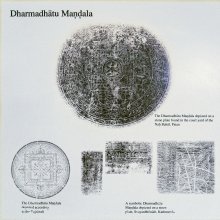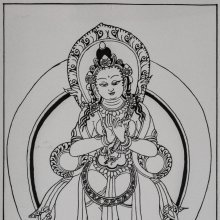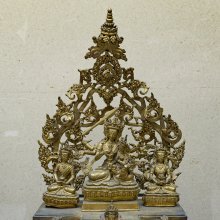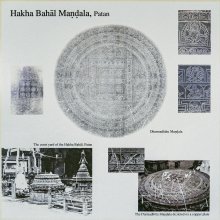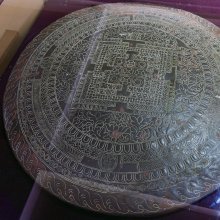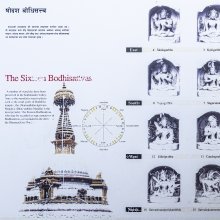Dharmadhatu, Dharma-dhatu, Dharmadhātu: 16 definitions
Introduction:
Dharmadhatu means something in Buddhism, Pali, Hinduism, Sanskrit, the history of ancient India. If you want to know the exact meaning, history, etymology or English translation of this term then check out the descriptions on this page. Add your comment or reference to a book if you want to contribute to this summary article.
Images (photo gallery)
(+7 more images available)
In Buddhism
Mahayana (major branch of Buddhism)
Source: Wisdom Library: LokottaravādaDharmadhātu (धर्मधातु) is the name of a Buddha under whom Śākyamuni (or Gautama, ‘the historical Buddha’) acquired merit along the first through nine bhūmis, according to the Mahāvastu. There are in total ten bhūmis representing the ten stages of the Bodhisattva’s path towards enlightenment.
Dharmadhātu is but one among the 500 Buddhas enumerated in the Mahāvastu during a conversation between Mahākātyāyana and Mahākāśyapa, both principle disciples of Gautama Buddha. The Mahāvastu is an important text of the Lokottaravāda school of buddhism, dating from the 2nd century BCE.
Source: Wisdom Library: Maha Prajnaparamita SastraDharmadhātu (धर्मधातु) refers to the “fundamental element” and is mentioned as one of the synonyms of Dharmatā (the ‘dharma-nature’ or ‘true nature’ of dharmas), according to Mahāprajñāpāramitāśāstra chapter XLIX. Accordingly, “dharmas taken individually (pṛthak, pratyeka) are empty. These emptinesses have their own respective modalities (viśeṣa) which are, however, Tathatā. Together they form a single emptiness: the dharmadhātu. [...] This dharmadhātu itself is also of two kinds: the first, with a mind free of attachment, distinguishes dharmas as each having its own nature (svabhāva, prakṛti); the second is the immense dharma (apramāṇadharma), i.e., the true nature of dharmas (dharmatā)”.
Notes: The Śrāvakas attain the dharmadhātu, but since their wisdom (prajñā) is limited (sapramāṇa), they cannot speak of its immensity (apramāṇam). In the case of the dharmadhātu, they are like the man who goes to the great ocean (mahāsamudra) to empty out the water but who uses a vessel (bhājana) so small that he cannot collect the immense waters.
Source: academia.edu: A Study and Translation of the Gaganagañjaparipṛcchā1) Dharmadhātu (धर्मधातु) refers to the “realm of the dharma”, according to the Gaganagañjaparipṛcchā: the eighth chapter of the Mahāsaṃnipāta (a collection of Mahāyāna Buddhist Sūtras).—Accordingly, “How then, son of good family, does the Bodhisattva relate to the guiding principle of the realm of the dharma (dharmadhātu-naya), being united with the realm of the dharma (sarva-dharmadhātu)? ‘The realm of the dharma (dharmadhātu)’ is the realm that is free from desire since it is free from any impurity; the realm of non-origination since it is not something in particular; the realm without cessation since there is no occurrence; the realm that does not go anywhere since there is no transmigration; the realm without coming since there is no passing over; the realm without abiding since there is no arising; the realm as it really is because of its sameness in all three times [...]”.
2) Dharmadhātu (धर्मधातु) refers to the “place of the absolute truth”, according to the Gaganagañjaparipṛcchā.—Accordingly, “Ratnaśrī said: ‘What is the place of the absolute truth (dharmadhātu)?’ Gaganagañja said: ‘It is not the place of birth nor the place of death, it is neither a place nor non-place. Such a place is the place of the absolute truth, and just the place of absolute truth is the place of all dharmas. The place of all dharmas is not a place, and that which is not a place is without place because there is no place of birth or place of death. Therefore, it is neither a place nor non-place. Such is the place of the tathāgata which is not considered as the place of birth nor the place of cessation. [...]’”.

Mahayana (महायान, mahāyāna) is a major branch of Buddhism focusing on the path of a Bodhisattva (spiritual aspirants/ enlightened beings). Extant literature is vast and primarely composed in the Sanskrit language. There are many sūtras of which some of the earliest are the various Prajñāpāramitā sūtras.
Tibetan Buddhism (Vajrayana or tantric Buddhism)
Source: archive.org: The Indian Buddhist IconographyDharmadhātu (धर्मधातु) or Dharmadhātulokeśvara refers to number 90 of the 108 forms of Avalokiteśvara found in the Machhandar Vahal (Kathmanu, Nepal). [Machhandar or Machandar is another name for for Matsyendra.].
Accordingly,—
“Dharmadhātu is identical with [Piṇḍapātra Lokeśvara] in form, but here the god holds in his two hands the water-pot near his navel.—Piṇḍapātra Lokeśvara is one-faced and two-armed and stands on a lotus. He holds the Piṇḍapātra (the bowl) in his two hands near the navel”.
The names of the 108 deities [viz., Dharmadhātu] possbily originate from a Tantra included in the Kagyur which is named “the 108 names of Avalokiteshvara”, however it is not yet certain that this is the source for the Nepali descriptions.Source: Brill: Śaivism and the Tantric Traditions (tantric Buddhism)
Dharmadhātu (धर्मधातु) refers to the “dharma-sphere”, according to the Nāmamantrārthāvalokinī by Vilāsavajra, which is a commentary on the Nāmasaṃgīti.—Accordingly, [while describing Mahāvairocana]—“And then [the Sādhaka should visualise] Mahāvairocana on the principal seat, generated by means of the syllable āḥ. [Why has he four faces?] Since consciousness—which is of the nature of the Dharma-Sphere since, by its nature, it lacks such forms as the grasped [i.e., the subject-object duality]—is four-faced. [This is] because the four liberation faces [/doors]—emptiness and the rest—are the cause of the origination of all meditative concentrations, [and this in turn is] because their ground is the Dharma-Sphere (dharmadhātu-svabhāva). [...]”.

Tibetan Buddhism includes schools such as Nyingma, Kadampa, Kagyu and Gelug. Their primary canon of literature is divided in two broad categories: The Kangyur, which consists of Buddha’s words, and the Tengyur, which includes commentaries from various sources. Esotericism and tantra techniques (vajrayāna) are collected indepently.
Buddhist philosophy
Source: Google Books: The Treasury of Knowledge: Book six, parts one and two (philosophy)Dharmadhātu (धर्मधातु) refers to the “expanse of reality” and represents one of the nine aspects of the “consummate nature” (pariniṣpanna), which represents one of the five parts of the “three natures” (trilakṣaṇa), according to Khewang Yeshe Gyatso, Exegetical Memorandum, chapter 7 (Cf. Śatasāhasrikāprajñāpāramitā).—The term “consummate nature” (pariniṣpanna) refers to the actual reality of all phenomena, the original ultimate [truth]. [...] The consummate nature also has nine further aspects [e.g., dharmadhātu], as is stated in the Extensive Mother (Yum rgyas pa).
-
General definition (in Buddhism)
Source: Wisdom Library: Dharma-samgrahaDharmadhātu (धर्मधातु) or simply dharma refers to the “thought element” and represents one of the eighteen elements (dhātu) as defined in the Dharma-saṃgraha (section 25). The Dharma-samgraha (Dharmasangraha) is an extensive glossary of Buddhist technical terms in Sanskrit (e.g., dharma-dhātu). The work is attributed to Nagarguna who lived around the 2nd century A.D.
Source: Google Books: Foundations of Indian PsychologyDharmadhātu (धर्मधातु) or Dharmadhātujñāna refers to the “pristine wisdom of the void sphere of reality” which represents one of the five inseparable aspects of pristine wisdom in Buddhist Psychology.—The ‘pristine wisdom of the void sphere of reality’ (dharmadhātu-jñāna) is the experience of truth ‘as it is’. The confused perspectives lead from this wisdom to concretized aspects as the aggregate of form. It is the same power of this wisdom that drives the affliction of bewilderment, when one diverts from the deeper investigation of the nature of truth, into confused identification with appearances. The comprehension of certain unchanging patterns within the ever-changing flux of appearances results in seemingly permanent forms. If one perfectly transcends bewilderment with insight (prajñā) and one-pointed concentration, one cuts through all appearances into the true nature of reality.
Source: WikiPedia: BuddhismHuayan teaches the Four Dharmadhātu, four ways to view reality:
- All dharmas are seen as particular separate events;
- All events are an expression of the absolute;
- Events and essence interpenetrate;
- All events interpenetrate.
India history and geography
Source: academia.edu: Elements of Newar Buddhist ArtDharmadhātu (धर्मधातु) is synonymous with Dharmodaya (“inverted triangle symbolizing the female principle”), according to the Hevajratantra-Tika.—The Newar Buddhist tradition of the (Kathmandu) valley prefers to identify Guhyeshvari with the dharmodaya triangle. [...] Such vulvial symbols are often represented in stone relief. An seventeenth century inscription found at the western section of the Cilamco stupa in Kiritpur tells us that such stone relief was known to the Buddhist community of the valley not exactly as dharmodaya but as dharmadhatu shrine. This is understandable because in esoteric Buddhist literature the word dharmadhatu is synonymous with dharmodaya. For instance, Hevajratantra-Tika explains that “dharmodaya is dharmadhatu because the worldly phenomenon or the noble dharma [directly] rises from here”.
Such dharmadhatu shrines are very different from the dharmadhatu mandalas which are round and laid flat on plinth-like high structures. The dharmadhatu shrines, on the other hand, are vertical stone slabs with pointed arch adorned with the Garuda or Kirtimukha motif flanked by two Makaras. Locally these shrines are also known as torana, “a gate” not only because the shrines appear like the gates of Newar palaces and temples but also because the inverted triangle symbolizes both the vulva and a celestial gate.

The history of India traces the identification of countries, villages, towns and other regions of India, as well as mythology, zoology, royal dynasties, rulers, tribes, local festivities and traditions and regional languages. Ancient India enjoyed religious freedom and encourages the path of Dharma, a concept common to Buddhism, Hinduism, and Jainism.
Languages of India and abroad
Sanskrit dictionary
Source: DDSA: The practical Sanskrit-English dictionaryDharmadhātu (धर्मधातु).—an epithet of Buddha.
Derivable forms: dharmadhātuḥ (धर्मधातुः).
Dharmadhātu is a Sanskrit compound consisting of the terms dharma and dhātu (धातु).
Source: Cologne Digital Sanskrit Dictionaries: Edgerton Buddhist Hybrid Sanskrit DictionaryDharmadhātu (धर्मधातु).—(1) m. (compare Pali dhamma-dhātu), sphere of religion; regularly rendered by Tibetan chos kyi (of religion) dbyiṅs (whereas khams is the usual Tibetan for dhātu, q.v.); according to [Tibetan-English Dictionary], dbyiṅs = space, expanse; sphere …also that which is massed in indefinite compass: tulye (so read with WT) nāma dharmadhātu-praveśe Saddharmapuṇḍarīka 60.8, see s.v. tulya; dharmadhātu-gagana-gocarāṇāṃ tathāgata- mahājñāna-sūryacandramasāṃ Gaṇḍavyūha 500.8 (the sun and moon of the great knowledge of the Tathāgata have the heaven of the sphere of religion as their scope, gocara); °tum eva vicārayamāṇo Rāṣṭrapālaparipṛcchā 4.10 (meditating on…); sarva-dharma- dhātu-prasṛtaṃ tathāgatajñānam Rāṣṭrapālaparipṛcchā 4.12; dharmadhātu- viśuddhiḥ Mahāvyutpatti 110, as one of the five jñāna, q.v. (where note variant of Dharmasaṃgraha 94); śive virajase 'mṛte dharma- dhātau pratiṣṭhāpayiṣyati Lalitavistara 227.1, he will establish (creatures) in the auspicious, pure, immortal sphere-of- religion; (parijñāto) dharmadhātur vyavasthāpitaḥ sattva- dhātuḥ Lalitavistara 351.9, he (Buddha) has completely understood the sphere of religion and established the ‘sphere’ (community, mass; see s.v. dhātu 6) of creatures (presumably sc. in religion); dharmadhātu-paramāṇy ākāśadhātuparyava- sānāni sarvabuddhakṣetrāṇy Lalitavistara 290.7—8 (…which make the sphere of religion their supreme interest…? but Tibetan chos kyi dbyiṅs kyis klas pa, probably which are beyond the [Page279-a+ 71] dharmadhātu, otherwise Foucaux); dharmadhātv-asaṃ- bheda-cakraṃ Lalitavistara 423.1, wheel that causes no confusion in the sphere of religion; ananta-madhya-dharmadhātv- avikopana-cakraṃ 3; dharmadhātu-samavasaraṇa-cakraṃ 7, wheel of attainment (see samavasaraṇa) of the sphere of religion. The [compound] dharma-dhātu seems to be used differently in AbhidhK, see LaV-P's Index. On the other hand, the use of it described by Lévi, Asaṅga (Mahāyāna-sūtrālaṃkāra) p. *24, can be recon- ciled with that which I have described, and which is the only use I have noted in my texts. (2) name of a former Buddha: Mahāvastu i.137.10.
Source: Cologne Digital Sanskrit Dictionaries: Monier-Williams Sanskrit-English Dictionary1) Dharmadhātu (धर्मधातु):—[=dharma-dhātu] [from dharma > dhara] m. ‘the element of l° or of existence’, one of the 18 Dhātus of the Buddhists
2) [v.s. ...] a Buddha (whose essence is l°), [cf. Lexicographers, esp. such as amarasiṃha, halāyudha, hemacandra, etc.]
Source: Cologne Digital Sanskrit Dictionaries: Yates Sanskrit-English DictionaryDharmadhātu (धर्मधातु):—[dharma-dhātu] (tuḥ) 2. m. A Jaina sage.
[Sanskrit to German]
Sanskrit, also spelled संस्कृतम् (saṃskṛtam), is an ancient language of India commonly seen as the grandmother of the Indo-European language family (even English!). Closely allied with Prakrit and Pali, Sanskrit is more exhaustive in both grammar and terms and has the most extensive collection of literature in the world, greatly surpassing its sister-languages Greek and Latin.
See also (Relevant definitions)
Partial matches: Dhatu, Dharma, Tarma.
Starts with (+16): Dharmadhatugaganapurnaratnashikharashripradipa, Dharmadhatugaganashrivairocana, Dharmadhatugaganashrivairochana, Dharmadhatugarbha, Dharmadhatujakaya, Dharmadhatujnana, Dharmadhatujnanapradipa, Dharmadhatukusuma, Dharmadhatulokeshvara, Dharmadhatunagarabhajnanapradiparaja, Dharmadhatunayajnanagati, Dharmadhatunayavabhasabuddhi, Dharmadhatuniyata, Dharmadhatupadma, Dharmadhatupaduma, Dharmadhatuparirakshini, Dharmadhatupranidhisunirmitacandraraja, Dharmadhatupranidhisunirmitachandraraja, Dharmadhatupranidhitalanirbheda, Dharmadhatupratibhasa.
Ends with: Suvishuddhadharmadhatu.
Full-text (+35): Dharmadhatuvagishvara, Dharmadhatuparirakshini, Dharmadhatuniyata, Bhutakoti, Spharin, Pharana, Anujava, Dharmadhatugarbha, Kathatva, Samsarakaya, Samavasarana, Anunatva Apurnatva Nirdesa, Five Knowledges, Chepu, Agniskandha, Dharmadhatulokeshvara, Prativedha, Atyanta, Sthapaniya, Anantamadhya.
Relevant text
Search found 25 books and stories containing Dharmadhatu, Dharma-dhatu, Dharmadhātu, Dharma-dhātu; (plurals include: Dharmadhatus, dhatus, Dharmadhātus, dhātus). You can also click to the full overview containing English textual excerpts. Below are direct links for the most relevant articles:
Maha Prajnaparamita Sastra (by Gelongma Karma Migme Chödrön)
II. The pratisaṃvids according to the Mahāyāna < [Part 3 - The four unhindered knowledges]
The Śāriputra-siṃhanāda-sūtra < [Part 2 - Understanding dharmatā and its synonyms]
IV. Supplementary explanations < [Part 2 - Understanding dharmatā and its synonyms]
Consciousness in Gaudapada’s Mandukya-karika (by V. Sujata Raju)
The false notion of duality < [Chapter 6: A Study of Māṇḍūkya Kārikā: Alātaśānti Prakaraṇa]
How the Ātman is obscured by the ignorant < [Chapter 6: A Study of Māṇḍūkya Kārikā: Alātaśānti Prakaraṇa]
The three levels of knowledge < [Chapter 6: A Study of Māṇḍūkya Kārikā: Alātaśānti Prakaraṇa]
Mahayana Buddhism and Early Advaita Vedanta (Study) (by Asokan N.)
Chapter 4.7 - Reality in Madhyamika (f): Dharmadhatu
Chapter 2.10 - The Psychological attitude of Buddhist Philosophy
The Great Chariot (by Longchenpa)
Part 1b.1f - How consciousness dissolves < [B. The extensive explanation of the nature of karma]
Part 4a.1 - Meditation on the protection circles < [B. The explanation of meditation practice, together with its action of ripening and freeing]
Part 1 - How peace is attained < [B. The explanation of the kayas and wisdoms]
Ksitigarbha Bodhisattva fundamental vow sutra (by Johnny Yu)
Chapter 10 - Comparison of Merits Derived from Giving Alms
Chapter 12 - Benefits from Admiring [Ksitigarbha's Statue] and Hearing [Ksitigarbha's name]
A Blessed Pilgrimage (by Dr. Yutang Lin)
Related products
